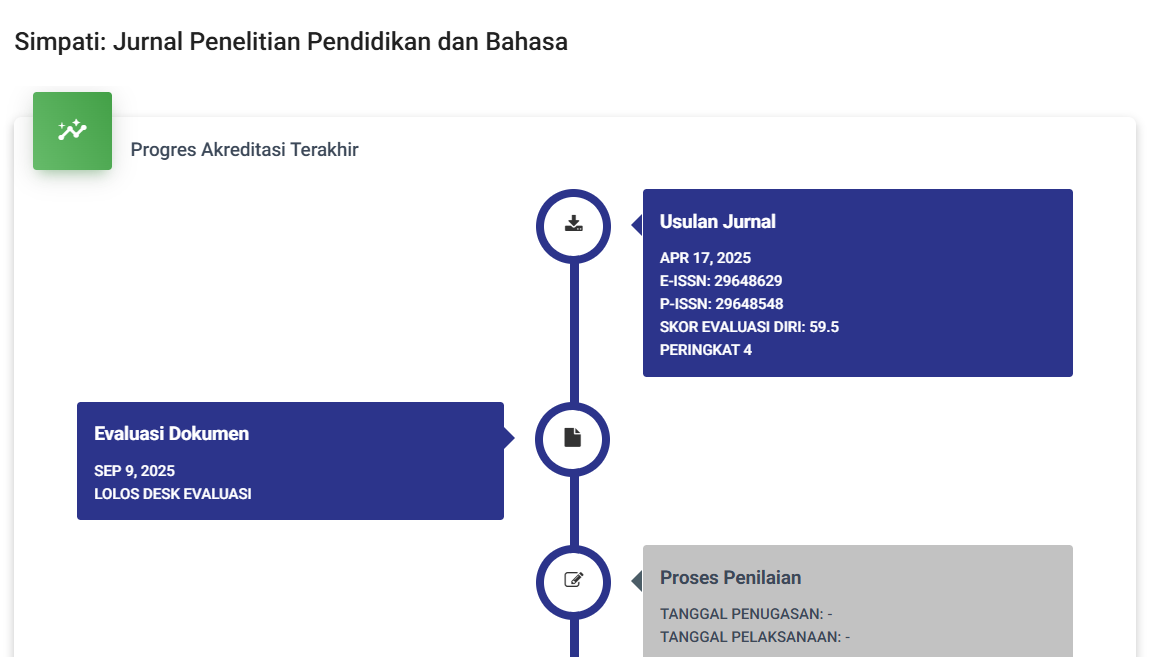A Cultural Content Analysis of English Textbooks Written by Native and Non-native Speakers
DOI:
https://doi.org/10.59024/simpati.v1i4.440Keywords:
Cultural Aspects, Target Language, TextbookAbstract
The examination of cultural content in textbooks enables educators to identify suitable course materials that effectively cater to the linguistic requirements of learners in a culturally appropriate manner. This study aimed to examine the cultural aspects of the target language in high school English textbooks, specifically "Bahasa Inggris 2017 revised edition Kelas X" and "English in Mind Second Edition (Student's Book 3) for Grade X." The research used Cortazzi and Jin's checklist of cultural types and Byram's criteria of Cultural Knowledge, Cultural Awareness, and Intercultural Competence. The data was gathered from two English textbooks for tenth-grade students written by native and non-native English speakers. The findings showed that Textbook 2, English in Mind for Grade X, had a higher cultural content compared to Textbook 1, Bahasa Inggris Kelas X. Textbook 2 presented more target culture-related content, covering 188 items, International culture 64 items, and the least presented type, Source culture 28 items. Both textbooks met the cultural aspects criteria as suggested by Byram's criteria but Textbook 2 contained more target culture-related content than Textbook 1. In conclusion, the ideal textbook for presenting more target cultural content is represented by Textbook 2, which is written by native speakers of English.
References
Akbar, A. H. (2019). Cultural Content Analysis of English Textbook at SMK Laniang of Makassar (A Library Research at The Tenth and Eleventh Grade of SMK Laniang Makassar). (S1 Thesis, Universitas Muhammadiyah Makassar).
Byram, Michael. (1994). Teaching-and-learning language-and-culture. Clevedon: Multilingual matters. p.51-52.
Cortazzi, M., & Jin, L. (1999). Cultural mirrors: Materials and methods in the EFL classroom. In E. Hinkel (ed.), Culture in the second language teaching and learning, Cambridge: Cambridge University Press.
Creswell, John W. (2014). Research Design: Qualitative, Quantitative and Mixed
Edmundson, M. (2016). Teaching and the Ethics of Literature. JOMEC Journal, Vol 0, No. 10, pp.40-43
Elshadelin, G., & Yumarnamto, M. (2020). Cultural Contents in Two English Textbooks in Indonesia: Representations and Sources of Culture. Beyond Words, 8(2), 60-77. DOI: https://doi.org/10.33508/bw.v8i2.2511
Endrayuni, E., Yusra, K., & Lestari, Y. B. (2021). Local Cultural Politeness in English Language Classrooms. doi: https://doi.org/10.2991/assehr.k.210525.057
Hidayat, W., Arifuddin, A., & Yusra, K. (2020). Varieties and Accessibilities of Online Materials for Oral and Written English Skills. doi: https://doi.org/10.2991/assehr.k.200827.014
Islam, M.T., Hussain, M., & Orthy, S. (2021). Cultural Diversity and Peaceful Coexistence: A Reflection on Some Selective School Textbooks. Social Science Review. Vol. 37, No. 2, pp. 59-84
Kiczkowiak, M. (2022). Are most ELT course book writers white ‘native speakers’? A survey of 28 general English course books for adults. Language Teaching Research, 0(0). https://doi.org/10.1177/13621688221123273
Kodriyah, L., Dayu, A., & Hakim, A. (2018). ELT Textbook Pros and Cons in EFL Environment: How Teachers should Make a Decision. Intensive Journal, 1(1), 1-8. doi: http://dx.doi.org/10.31602/intensive.v1i1.1239
Mustofa, M. I. (2019). The Analysis of Cultural Content in EFL Textbooks Used at SMA IT Iqra’ And SMKN 1 Grade X Bengkulu City. (S1 Thesis, IAIN Bengkulu).
Nunan, D. (2003). Practical English Language Teaching. New York: McGraw-Hill.
Prayatni, I., Yusra, K., & Tohir, L. (2020, August). Intercultural Miscommunication with Local People: A Descriptive Study on Foreigners’ Perception and Experiences. In 1st Annual Conference on Education and Social Sciences (ACCESS 2019) (pp. 31-35). Atlantis Press. doi: https://doi.org/10.2991/assehr.k.200827.009
Quester, P.G., Karunaratna, A. and Kee Goh, L. (2000), Self‐congruity and product evaluation: a cross‐cultural study. Journal of Consumer Marketing, Vol. 17 No. 6, pp. 525-535.
Rahmawati, D. S. A. (2020). Culture Representation in English Textbook: Content Analysis of Textbook Bahasa Inggris For Grade X Senior High School. (S1 Thesis, IAIN Purwokerto).
Rajabi, S., & Ketabi, S. (2012). Aspects of cultural elements in prominent English textbooks for EFL setting. Theory and Practice in Language Studies, 2(4), 705-712. doi: https://doi.org/10.4304/tpls.2.4.705-712
Richards, J. C. (2010). Competence and Performance in Language Teaching. RELC Journal, 41(2), 101–122. doi: https://doi.org/10.1177/0033688210372953
Szőke-Milinte, E. (2013). Theory and Practice in Communication Course Books. Acta Didactica Napocensia. Vol. 6, No. 3, pp. 45-54
Yusniawati, N. L. P. I., & Lestari, Y. B. (2021). The Potential of Local Culture in English Language Teaching (ELT): A Response Paper to Domination of English Material in ELT. doi: https://doi.org/10.2991/assehr.k.210525.098
















